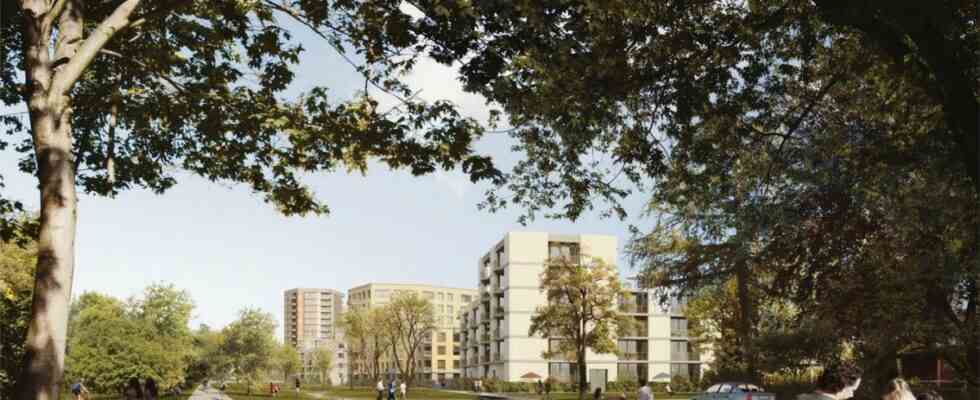1,370 new apartments on a former Siemens site in Obersendling, 820 new apartments on the “Truderinger Acker” in Berg am Laim: On Wednesday, the city council’s planning committee awarded the building permit for two large private housing projects with new living space for a total of around 5,000 people. While the project in Obersendling went through without any significant debate, there was a detailed discussion about the extent of the development and possible effects on the urban climate and traffic around the “Truderinger Acker”.
“Some things are on our minds,” said Anna Hanusch from the largest city council faction of Die Grünen/Pink Liste, citing the location of the construction project in a green corridor as an example. “But we weighed it up overall,” added Hanusch. “The basic concept and the construction of apartments are good and correct.” That is why they “happily” agree to the resolution in the statutes for the development plan and “hope that construction will start soon”. Dissenting votes came only from Brigitte Wolf (Die Linke/The Party parliamentary group), Dirk Höpner (ÖDP/Munich List) and Fabian Ewald, who veered from the affirmative line of his CSU/Free Voters group.
The building plot on Truderinger Strasse, seen from the north.
(Photo: Jakob Michael Berr)
The building site is located near the Berg am Laim S-Bahn station, more precisely south of Truderinger Strasse, west of Roßsteinstrasse and east of Schwanhildenweg. Investors are the Büschl group of companies from Grünwald and the Rothenfusser family, who have owned the area for more than 100 years and sold half of it to Büschl. According to the rules of socially just land use (in the now outdated Sobon version from 2017), 30 percent are subsidized and 10 percent are price-controlled living space, and 60 percent can be used at Munich market prices. A special feature of the project is that the Büschl Group has sold 200 subsidized apartments to the municipal Gewofag. These apartments do not fall out of the bond after 25 or 30 years, but remain affordable in the long term – a model that Alexander Reissl (CSU) described as “very charming” and a possible model for other private housing projects.
In addition to the statute resolution, the SPD-Volt parliamentary group submitted an application in which they demanded that 100 Gewofag apartments be “specifically tailored to the needs of older people”. In the years-long process for the project, “it became clear how high the need for special forms of housing for senior citizens” was, especially in Berg am Laim, explained SPD city councilor Christian Köning, and they wanted to react to this.
Fabian Ewald from the CSU described the application as “window dressing” and that “hardly any social infrastructure was created”. Ewald referred to the resolution submitted by City Planning Officer Elisabeth Merk. She writes that in the talks with the two investors “no possibility was seen” of creating a care facility for the elderly and a meeting place for teenagers. Brigitte Wolf from the left criticized that the density of the building “is much too high” and that the high-rise building with 15 floors in particular is primarily used to create expensive apartments “with an unobstructed view to the south”.
Jörg Hoffmann, parliamentary group leader of the FDP/Bavarian Party, saw things very differently: “High-density housing construction is exactly what we are always demanding, it relieves the housing market.” However, he said that one only agreed “with a great deal of stomach ache” because the streets around the new development quarter were “already overloaded”. He fears that this will only get worse in the future.
“Very successful example of restructuring”
There were significantly fewer requests to speak about the even larger construction project on Hofmannstrasse in Obersendling, west of Baierbrunnerstrasse and east of the “Siemenswäldchen”. There are still up to eight-storey commercial buildings on the 13-hectare site, they are legacy from Siemens. The Grünwald-based real estate company Rock Capital can now build a seven-storey complex there, which winds around four courtyards, and seven high points, each with 13 storeys, are planned. In addition, the property will be accessible to the public through new paths. All city councilors except for the left-wing Brigitte Wolf and Dirk Höpner from the Munich list approved the resolution for the project, which already bore the names “Hofmann Höfe” and “Campus Süd”.
The urban design for the residential quarter on Hofmannstraße by Rapp und Rapp dates back to 2015.
(Photo: Patrizia AG)
This project, which was significantly delayed after Patrizia sold the property to Rock Capital in 2017, will only have 30 percent subsidized housing and a small proportion of 70 low-priced apartments. This is the result of a compromise between the city and Rock Capital because the applicable Sobon rules were in dispute in this case.
The builders have undertaken to observe high standards in climate protection. SPD city councilor Micky Wenngatz suggested creating more green facades. “Otherwise, however, it is a very successful example of restructuring,” said Wenngatz.

